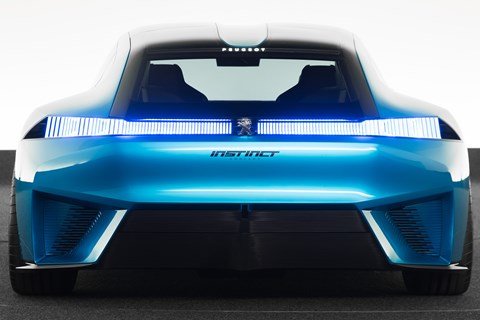► Peugeot Instinct concept for Geneva 2017
► Autonomous shooting brake for 2025
► Emphasis on future interior innovation
One of the concept car stars of the 2017 Geneva motor show is the Peugeot Instinct, an autonomous shooting brake with active aerodynamics, shape-shifting seats and concrete interior trim (yes, really).
We’ve been inside the concept at Peugeot’s Paris design studios for an up-close look in advance of the show – here are the key design highlights to seek out under the show lights in March.
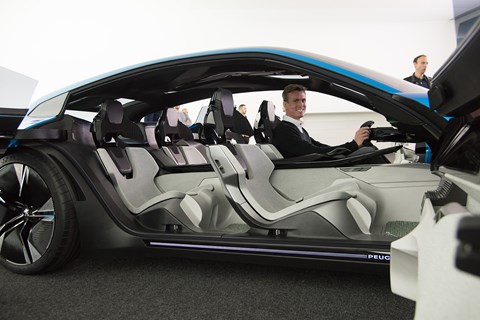
1) Those seats
The Instinct’s shard-like exterior is dramatic, but the concept’s focus is its futuristic four-seat interior, nominally designed for the year 2025.
‘We started the design on the inside,’ Matthias Hossann, Peugeot’s head of concept cars, told CAR. ‘Often autonomous concepts have a very big interior, with seats that swivel through 180 degrees, for example. [In the Instinct concept] we kept the interior the size of a typical production car interior. This interior occupies the same amount of space as a 308, roughly, but with a lower roof.’
‘Seats that can be turned are unrealistic with a compact car. [Instead] we invented an “adaptive-fit seat” with a sliding seat base.’
When the car enters one of its autonomous driving modes (more on which shortly), the seats can slide forwards and downwards into a hammock-like reclined position, the better to grab 40 winks or thumb through some reading. We tried sitting in both upright and reclined positions, and the seats manage to support upper body and shoulders effectively even at their most laid-flat.
Sitting in the back, the front seats are designed in such a way as to avoid stealing much legroom when in hammock mode.
‘When you’re on a plane and someone puts their seat back in front of you, it can be horrible,’ says Hossan. ‘We want to avoid that.’
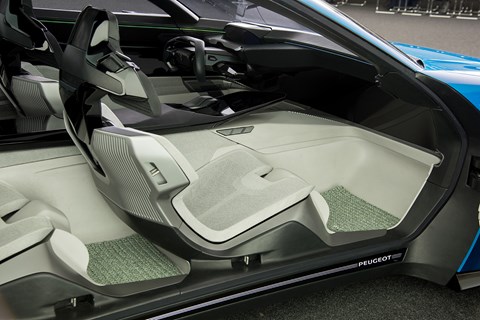
2) Leftfield materials
‘We used materials like you would find in the home,’ interior designer Arthur Condert told us. ‘Materials that are nice to touch. The seat fabrics are the same as many sofas, and on the doors and on the floor, we used a very thin layer of concrete – it has a nice texture, and becomes warm to the touch.’
The concrete really is a thin veneer, by the way, so doesn’t add another tonne to the kerbweight.
The thick knitted carpets on the floor are sourced from Israel, while the 3D ‘digital knitting’ surfaces on the seats are similar to the type of material you’d see in modern trainers.
‘We are exploring using more of these “noble” materials rather than plastics,’ Condert told CAR. ‘They are more expensive, but we try to use them in an intelligent way.’
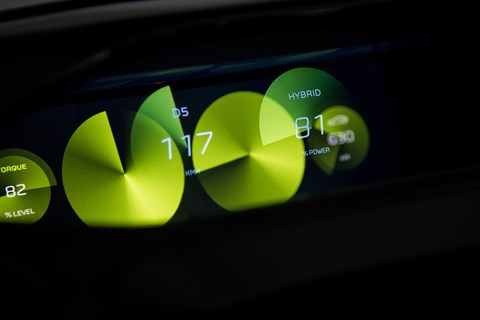
3) Holographic instruments
The next step in Peugeot’s small wheel/raised instruments ‘i-Cockpit’ set-up, the three-dimensional holographic instrument screen features deliberately clear, simple graphics.
In manual drive mode it displays vehicle speed, battery level and so on, while in Autonomous mode it switches to show distance covered so far, and the remaining journey time.
Lower in the driver and passengers’ field of vision is a giant widescreen display recessed within the dash.
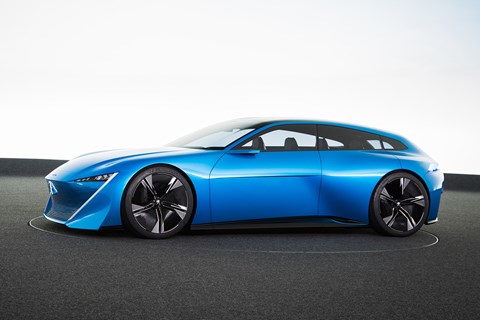
4) That exterior
The brief was ‘to design a highly desirable autonomous car,’ Matthias Hossann told us. ‘We wanted the exterior to be as smooth and simple as possible.’
The Peugeot Instinct’s shooting brake form was partially inspired by the Peugeot 504 Riviera of 1971, he tells us, and the XL grille treatment by the 402 Andreau of 1936. ‘The front of car has to inspire this notion of efficiency. We design the 3D-printed grille to look as “full” as possible.’
There’s no B-pillar, and the giant doors open like the pages of a book, as far as 90deg to the body.

5) First look at Peugeot’s next-gen headlights
That cuboid headlamp design is likely to reappear on future production Peugeots.
‘One of the elements we want to push in the future is to integrate radars, sensors, lasers into the lights,’ says Hossann. That’s the black spot you can see in the centre of the lights: ‘It’s like a pupil,’ he says. ‘We want people to always when they see a Peugeot, to look it in the eyes.’
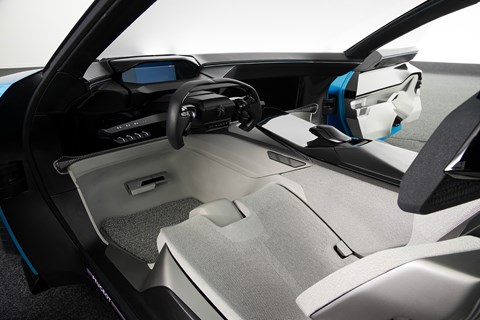
6) Focus on self-driving tech
The Instinct’s main thrust is that it represents Peugeot’s take on the concept of autonomous cars. ‘Self-driving cars are the next automotive revolution. Every manufacturer will be offering this technology. The difference will lie in how they go about it,’ is Peugeot’s official line.
The Instinct is designed with four driving modes, two manual (Drive Boost and Drive Relax – the latter partially assisting the driver) and two robot (Autonomous Soft and Autonomous Sharp – the latter piloting the car as quickly as comfortably possible).
While in either of the Auto modes, the driver can tap the gearlever-like command stalk on the centre console to tell the car to overtake traffic ahead, or switch between modes.
Like many recent autonomous car concepts, the steering wheel retracts into the dash in autonomous mode, but does so in a particularly neat way, folding itself gracefully flush with its surroundings. Likewise, the throttle pedal retreats further into the footwell in Auto mode.
‘The good point [about autonomous driving technology] is you can master your time,’ says Hossann. ‘You can choose between driving or doing something else – decide to sleep, to eat, to read – amplify your life.’
Cryptically/alarmingly, he adds that in Autonomous Sharp mode, the car can be programmed so that ‘Sebastien Loeb can drive you to work everyday. Autonomous mode doesn’t mean boring.’ Does that mean you can send Seb the bill for the tyres, we wonder?
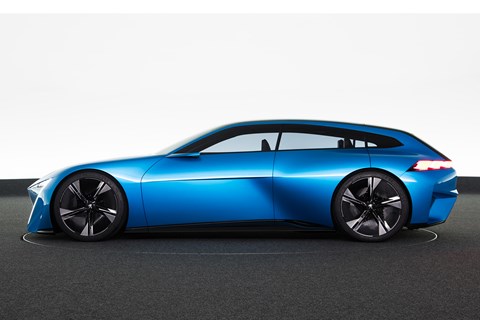
7) Trick aerodynamics
One of the concept’s party pieces is an extending front spoiler that incorporates the entire light guides (those diagonal DRL mandibles), joined by a downforce-aiding connecting strip. Deployed automatically above 55mph, it also helps to tidy airflow around the wheelarches – and looks quite neat in the process.
The crease along the Instinct’s flank incorporates a hidden channel guiding airflow to an outlet in the rear wheelarch, helping to reduce drag while also helping the design avoid appearing slab-sided. ‘Aerodynamicists hate sculpted sides – they want flat surfaces,’ Matthias Hossann explains.

8) It’s connected to the Internet of Things
Using an open platform developed in collaboration with Samsung, the Instinct’s infotainment systems are designed to be connected to smartphones, smartwatches – and also items in the home such as smart TVs (for instance, you could continue watching a film where you left off when you climb into the car), or automatically locking the house doors when you start the engine.
Don’t expect this to be the last time you hear about ‘IoT’ functions on a concept car in 2017…
Peugeot Instinct concept in a nutshell:
- Nominally designed for the year 2025
- Four-seater shooting brake with manual and autonomous driving modes
- Plug-in hybrid petrol-electric 4wd drivetrain with 300bhp
- Unorthodox interior materials, including knitted carpets and concrete veneers
- Seats can slide into reclined positions in Auto mode
- ‘Internet of Things’ connectivity with objects at home
- Square headlight graphics incorporating sensors likely to appear on future production Peugeots
- Sweeping rear light graphics differentiate between driving modes
- Official debut at 2017 Geneva motor show, before beginning global show tour
Click here for CAR’s full A-Z of the 2017 Geneva motor show
